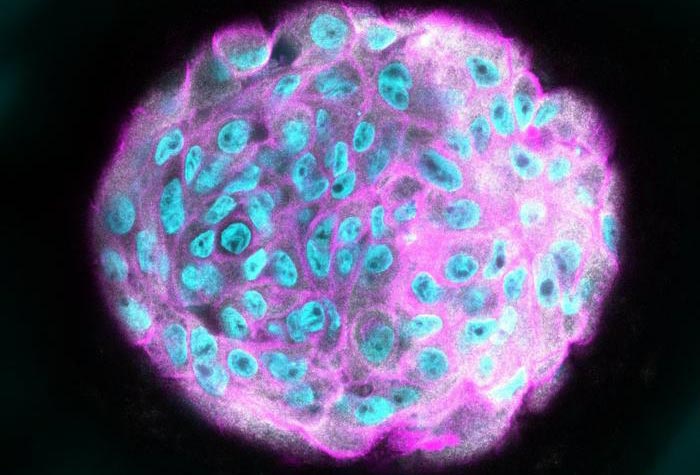Preventing the tissue’s response to stiffness

Breast cells acting non-invasively due to the presence of laminin.
Credit: Institute of Bioengineering of Catalonia
… may be key to slowing the progression of breast tumors.
A study led by the IBEC demonstrates that laminin, a protein present in healthy breast tissues, prevents the effects of stiffening, protecting cells against tumor growth.
Cells are capable of translating mechanical changes into biological responses. This process is known as mechanotransduction and plays a fundamental role in the progression of solid tumors, such as breast cancer.
It is well-established that a common mechanical alteration in cancer progression involves tissue hardening. This stiffness is precisely what is detected during self-examinations or breast palpations for potential tumor detection. The stiffness of breast tissue triggers a chain reaction, inducing tension within cells and distorting their nuclei. Ultimately, this nuclear deformation activates genes responsible for controlling cell proliferation, which are closely associated with tumor growth.
A study published today in the journal Nature Materials demonstrates a cellular mechanism that could be pivotal in slowing the progression of breast tumors. The results of the study, led by Pere Roca-Cusachs, the principal investigator at the Institute of Bioengineering of Catalonia (IBEC) and the University of Barcelona, indicate that laminin, a protein that provides structure and support to healthy breast tissues, hinders the mechanotransduction process in cells, thereby protecting the nucleus from deformation.
“Our findings demonstrate that the presence of laminin mitigates the effects of stiffness, effectively shielding cells from tumor growth. We have showcased this mechanism in vitro, but we believe it holds potential for in vivo application, considering what we have observed in samples from breast cancer patients.” Explains Zanetta Kechagia, postdoctoral researcher at IBEC and first author of the study.
“Through this mechanism, which we have shown can prevent the invasion of tumor cells, there is potential for the development of more sensitive diagnostic tools or even new therapies for breast cancer. However, further research will be needed to explore these possibilities, Pere Roca-Cusachs, IBEC researcher, Serra-Hunter associate professor at the University of Barcelona (UB) and leader of the study, explains.
It has already been demonstrated that an increase in tissue stiffness triggers mechanical responses within cells. The most common responses are associated with alterations in the cell’s cytoskeleton, affecting its interaction with the surrounding tissue and facilitating migration. Additionally, this stiffness leads to the activation of the YAP protein, which enters the nucleus and initiates the expression of genes linked to cell proliferation.
To study the mechanotransduction process, the research team cultured breast tissue cells on gels with varying stiffness to mimic both healthy (soft) and malignant (stiff) tissues. They compared the behavior of the cells on gels coated with laminin to those on gels coated with collagen or fibronectin, which are other cell-supporting proteins that are overproduced in carcinogenic processes.
Thus, the researchers observed that the cells seeded on the laminin-rich gel had a very mild mechanical response to the stiffness of the substrate, compared to those seeded on the gels rich in collagen and fibronectin.
As a result, the researchers observed that the cells seeded on the laminin-rich gel exhibited a significantly less pronounced mechanical response to the substrate’s stiffness when compared to those seeded on gels abundant in collagen and fibronectin.
This work is part of the European project MECHANO· CONTROL, receiving funding exceeding 7 million euros within the framework of the European FET (Future and Emerging Technologies) projects.
“These results represent the culmination of over 6 years of work, during which we received support from the European Commission and collaborated with a team of international institutions, led by IBEC, to better understand how mechanical forces impact breast cancer,” said Daniel Caudepón, IBEC project manager overseeing MECHANO·CONTROL.
This research also includes significant contributions from other institutions participating in MECHANO-CONTROL, such as Pablo Sáez and Marino Arroyo from Universitat Politècnica de Catalunya, and Thijs Koorman and Patrick Derksen from University Medical Center Utrecht, The Netherlands.
Journal: Nature Materials
DOI: 10.1038/s41563-023-01657-3
Method of Research: Experimental study
Subject of Research: Cells
Article Title: The laminin–keratin link shields the nucleus from mechanical deformation and signalling
Article Publication Date: 14-Sep-2023
Media Contact
Angels Lopez
Institute for Bioengineering of Catalonia (IBEC)
alopez@ibecbarcelona.eu
Office: 934-037-299
All latest news from the category: Life Sciences and Chemistry
Articles and reports from the Life Sciences and chemistry area deal with applied and basic research into modern biology, chemistry and human medicine.
Valuable information can be found on a range of life sciences fields including bacteriology, biochemistry, bionics, bioinformatics, biophysics, biotechnology, genetics, geobotany, human biology, marine biology, microbiology, molecular biology, cellular biology, zoology, bioinorganic chemistry, microchemistry and environmental chemistry.
Newest articles

New model of neuronal circuit provides insight on eye movement
Working with week-old zebrafish larva, researchers at Weill Cornell Medicine and colleagues decoded how the connections formed by a network of neurons in the brainstem guide the fishes’ gaze. The…

Innovative protocol maps NMDA receptors in Alzheimer’s-Affected brains
Researchers from the Institute for Neurosciences (IN), a joint center of the Miguel Hernández University of Elche (UMH) and the Spanish National Research Council (CSIC), who are also part of…

New insights into sleep
…uncover key mechanisms related to cognitive function. Discovery suggests broad implications for giving brain a boost. While it’s well known that sleep enhances cognitive performance, the underlying neural mechanisms, particularly…



